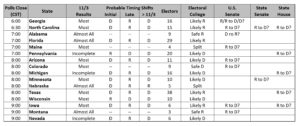Two days remain until Election Day in the United States. I’ve done the math, but I’m still crossing my fingers and wishing on every star I can find.
In addition to the Presidential election, there are 35 U.S. Senate races, 435 U.S. House races, 11 Governor’s races, 5,876 races in 86 state legislative chambers in 44 states, an abundance of state and local races for judges, commissioners, sheriffs, school boards, etc., and a slew of state and local ballot initiatives.
While many local elections aren’t of massive concern outside of their jurisdictions, this year’s state legislative races can have national implications. The newly elected state governments will be redrawing voting districts across the U.S. in our one-a-decade gerrymandering circus.
I’ll personally be watching the returns all night on 11/3, flipping between several national and local TV news channels while surfing multiple websites. Each of the major outlets will be providing their own spins as the night progresses – some based on analytics, some based on opinions, none with any chance of being 100% correct. While the probability that everything will be decided the evening of 11/3 is quite low, the consensus of various perspectives by the end of the night could at least give us a decent idea how close things are, how long we’ll be dealing with the aftermath, and how painful the experience will be.
There’s a lot to follow but, since many races simply aren’t that competitive, we can narrow our focus quite a bit.
Below is the national version of my 2020 elections “cheat sheet” with the states and races that I’ll be most closely following. I’m not addressing any U.S. House races since, barring any massive miscalculations, the U.S. House should remain under Democratic control.
Click the table for a larger version; use the browser’s back button to return here.
- Polls Close: This is the latest time (CST) that polls close in the states that I’ll be following. Some states stagger their closings across time zones but initial results will mostly be withheld until the whole state is closed. Each state will report results in their own unique ways. See below.
- State: These are the 17 states that I’ll personally be monitoring for at least one reason as noted herein.
- 11/3 Results: This is my oversimplified take on the amount of total votes that will be counted by midnight on 11/3.
- Almost All: Only a virtual tie at midnight should take longer to resolve.
- Most: If the results are within a couple of percentage points at midnight, things could change as the final votes are counted.
- Incomplete: It’s unlikely that elections will be called by midnight, regardless of the reported results at that point.
- Probable Timing Shifts: This is my very oversimplified take on how the state’s results may shift as votes are counted over time. It is based on when and how absentee, mail-in, early, and same-day voting results are counted and reported in each state. The probable D & R timing biases are noted as “Initial”, “Late”, and “>11/3”. For example, a D/R/D shift means that the first reported votes will likely favor Democrats, Republican will be favored in votes counted late on 11/3, and Democrats will be favored in votes tabulated after 11/3.
- Electors: The number of Electoral votes that are up for grabs in the state.
- Electoral College: My analytic categorization of the state, matching my 10/20 post – except for Texas. I moved Texas from Safe D to Likely D not because my model says it actually changed. It’s purely wishful thinking on my part. The two Split states aren’t winner-take-all and, since every Electoral vote could count at this point, my model has Maine with 3 Safe D & 1 Likely D and Nebraska with 4 Safe R & 1 Likely D.
- U.S. Senate: While I haven’t changed any projections from my 10/20 post, I will be watching several races that may be pretty close. In Georgia, for example, both Senate seats are on the ballot and both are worth watching. (I’ll frankly also be hoping for true miracles in Kentucky, South Carolina, and Texas with excellent Democratic candidates defeating McConnell, Graham, and Cornyn. Those wins, however, are unlikely at best.)
- State Senate: These are the state upper chambers that could flip control.
- State House: These are the state lower chambers that could flip control.
Of particular concern are those states that will have incomplete counts (for various reasons) until after 11/3 but that could have an early bias towards Republicans. This include Pennsylvania, Michigan, and Nevada – all states that are likely to vote Democratic when all of the votes are finally counted. Trump and Company, however, have made it quite clear that they intend to go to court to stop counting votes if they’re ahead and appear to be in trouble. Indeed, they’re already in court in multiple states (Texas included) trying to invalidate votes that have already been cast and/or votes that are processed after 11/3 – even if postmarked by 11/3 in accordance with state laws.
The possibility of having our President and control of the U.S. Senate determined by one Supreme Court justice who has been newly rammed onto the court by Republicans isn’t just a nightmare. It’s a real possibility.
The best hope for Democrats is a blowout – taking all of the Likely D states by large margins and picking off a couple of the Likely R states. I don’t see it, but I’ll definitely be wishing for it.
